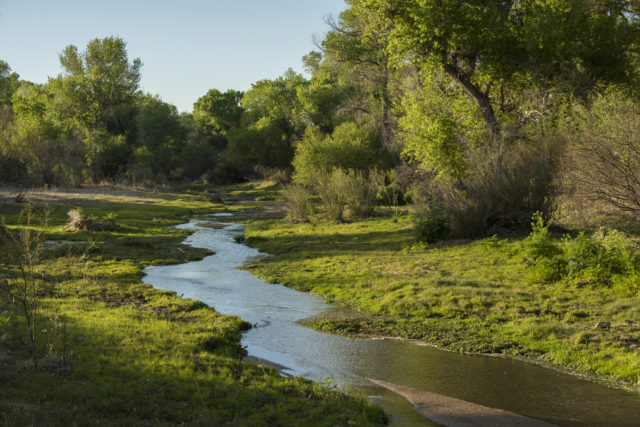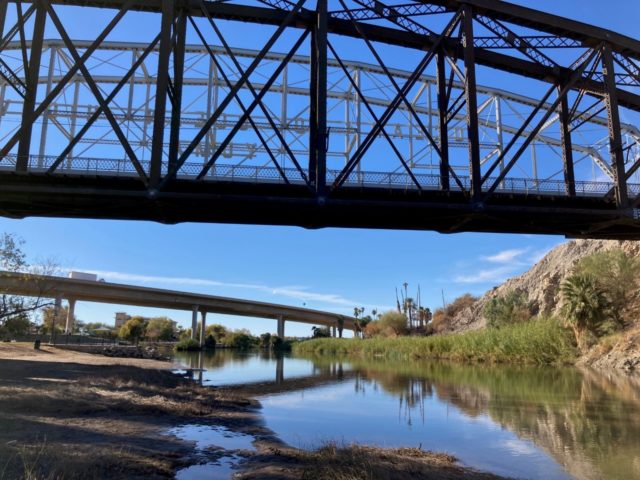This is part two of a series – read part one here.

©Bill Hatcher 2018
Here, the journey continues of water along the Santa Cruz River’s course, taken up by a distant cousin by union to the water from which we began.
This cousin droplet started in the Colorado River. From headwaters in the Rocky Mountains, through canyons and confluences, lakes, dams, and turbines, it travelled through five U.S. states until being picked up by the Central Arizona Project in Lake Havasu, on the Arizona-California border. From here, it was transported by canal and pumping plant up almost 3,000 feet and over 336 miles to recharge basins in Avra Valley, where it was released to filter into the aquifer from which the City of Tucson pulls its municipal water supply. Like our droplet before, this one is picked up by wells and travels through the municipal system, from plumbing to treatment. At the Heritage Project Outfall in downtown Tucson, it is released from a reclaimed water pipeline and joins the second effluent-dependent stretch of the Santa Cruz River. Perhaps someday this stretch will extend all the way to meet the next, and the droplet will be able to travel through Tucson and the Town of Marana, joined by downstream contributions from Agua Nueva and Tres Ríos Wastewater Reclamation Facilities. Maybe one day it could go even further, passing northward out of the county into Pinal before sinking once again into the sandy bed of the river. For now, however, there is usually a dry gap after the Heritage Project and sometimes another in between the flows from Agua Nueva and Tres Ríos.
If our droplet were able to carry on filtering downstream past Marana, it would ultimately find the end of the Santa Cruz River’s course, though not of its own journey. Moving through acres of agriculture, it could be drawn into wells used for irrigation and diverted into thirsty plants or evaporated into the sky. The Santa Cruz River, however, is a tributary to the Gila River, which is in turn a tributary to the Colorado. If our waterdrop were to flow into the Gila it could go on to the same river it came from, some miles downstream from where it left. It would join water that had sidestepped both the Central Arizona Project and the intake for the Colorado River Aqueduct, that had slunk past Parker Dam at the end of Lake Havasu, and Headgate Rock Dam too, on its way to Imperial Dam and the All-American Canal.

Some flow is diverted into La Paz County for municipal or agricultural use, some is picked up by the All-American canal and shipped to California to water the gardens of agriculture in the Imperial Valley and help feed the nation. The remaining water welcomes our droplet back into the river’s flow at the Gila River confluence. From its reentry into the Colorado, our water droplet could still be diverted into Yuma County, but maybe it continues south with what little water remains, heading towards Morelos Dam in Mexico. Here, the last of the river is stopped for people’s use, the last of the water is diverted and put to work in Mexicali, and the riverbed beyond runs dry.
South of Morelos Dam, leading into the Gulf of California and the Sea of Cortez, lies the Colorado River Delta. Once a vibrant and verdant environment providing a home for birds, fish, and various others besides, it dried and desiccated with the diminishing river, which had a minimal presence from the mid-1900’s until Minute 319 in 2012. This was a landmark addendum to the 1944 USA–Mexico Water Treaty that initiated a 5-year pulse-flow experiment to bring water once again to the Delta, picking up our droplet and tumbling it south towards the Sea of Cortez. In 2017 Minute 323 was signed, in part supporting water supply for continuing restoration efforts in the Delta until 2026.
Our droplets took a long journey for one of them to finally make it to the sea, supported and imperiled in turn all along the way. Through releases like those from the Nogales treatment plant, Heritage Project, and Agua Nueva and Tres Ríos facilities, we are helping to support the river and create a new and brighter future for the environment around us. Work continues in support of the Santa Cruz and the Colorado River Delta. Sonoran Institute proudly plays its part, with an active front operating in the Delta, Mexicali, and the greater Tucson area. While it is a part of the charm and mystery of running water—wondering where it is going and where it has been—our world is now mapped out, both above and below ground. Romantic fancies might appreciate not knowing all of the answers, but it is our responsibility as stewards of the environment to know something of the places we inhabit. In doing so, we become a part of these places, and they a part of us. Through such understanding, mutual support can be fostered, and life allowed to thrive.
Written by: Madeleine Oliver.
